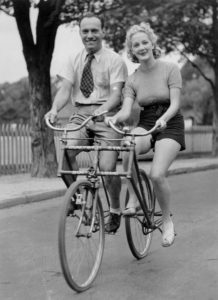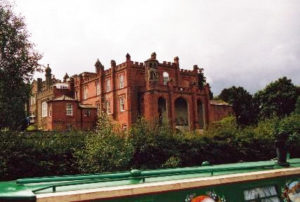Saint Christopher's Catholic Cycling Club
One Name – One Faith – One Badge
 Why have a Catholic Cycling Club?
Why have a Catholic Cycling Club?
In the 1930s cycling was for many the form of transport and following the War many cycling clubs flourished for touring and racing.
The activities which were organised at the weekend conflicted with those of the churchgoers. Priests complained that they were losing their altar boys not to mention members of their congregation.
Veronica Floate a young lady from London wishing to ride her new bicycle within a cycling club prompted by her father advertised in the Catholic newspaper. She soon realised from the number of replies that there was a need for a catholic cycling club. She set up the first meeting on 11th February 1935 and with later help from Carl Eherenzeller founder of the Birmingham Catholic Cycling Club the “London St. Christophers Catholic Cycling Club” was established.
Club cycle runs were organised usually on a Sunday. Riders would tour the countryside until a stop for lunch at a venue where pots of tea with additional jugs of hot water were served. It was accepted that your own food could be eaten on the promises whilst the most affluent could purchase beans, cheese or egg on toast. Riding would continue in the afternoon to another tea place where the hard riders and racing contingent would join up socially. A leisurely ride back home via a country pub would complete an all day event.
Catholic cycle runs followed a similar pattern. However the start of the ride would be organised at a suitable time and place so that riders could attend mass before setting off. During the day they might meet up with another section of the club, e.g. Manchester and Liverpool or North Staffs. Visits to places of Catholic interest and rallies were popular. After the tea stop on the way home tourists, hard riders and racing cyclists regularly attended benediction in a countryside church.
Social and Sporting Activities
One night in the week would be devoted to social and sporting activities; table tennis, snooker or weight training and riding on rollers for the racing cyclists. The club room was very often situated in the local school or Church meeting room. Monthly committee meetings would be attended by a spiritual director and up to 10% of non-catholics membership could be allowed. On the disbanding of the National body both Glasgow and Leeds opened up their membership, continued as St. Christopher’s but dropped the word “Catholic” from the title. They are still involved very successfully in all aspects of cycling.
The sections were affiliated to the R.T.T.C. for time trial racing, the N.C.U. for track and road racing and C.T.C. for touring. These organisations also provided third party insurance and limited legal protection to the club riders. Racing members would attend mass very early in the morning often at a local hospital to be in time for the early start. Until masses were provided on Saturday or Sunday nights long distance races were not considered available to catholic riders. Appeals to bishops for dispensation were rarely granted and the completion of all events for the B.A.R. national trophy was difficult. Indeed Joe Pond offered a trophy for the rider who completed the longest distance in 24 hours and attended mass!

Weekend visits to youth hostels were popular and catholic youth centres provided similar accommodation. Spode House near Rugeley was considered the National headquarters where a Dominican monk Father Conrad Pepler was warden, a most tolerant man, he could cope with the demeanors of a robust mix of Merseyside, Black Country and London youth.
National events organised at Spode included conferences, retreats, lectures, rallies, dinners, working parties, blessing of the bicycles and religious devotions. A short motherly Italian lady, Tina, with helpers, completed the picture as they served the hungry cyclists after a long day in the saddle or at a meeting. Washing up was done by the members who tried to avoid the dreaded “tins”. British Isles, France and “Tour de France” venues were very popular.
Pilgrimages to Walsingham and Holywell were well supported and attracted riders from all over the country. Hundreds of miles would be undertaken by family members, the children in seats, sidecars and trailers. Later when cars were following the group small children could ride their bikes for short distances before being picked up by the “sag” wagon.
